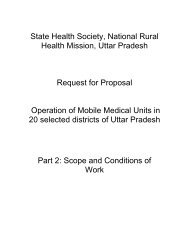Obstetrics Manual for Merrygold Hospitals - State Innovations in ...
Obstetrics Manual for Merrygold Hospitals - State Innovations in ...
Obstetrics Manual for Merrygold Hospitals - State Innovations in ...
Create successful ePaper yourself
Turn your PDF publications into a flip-book with our unique Google optimized e-Paper software.
Unit 2.6 Hypertensive Disorders <strong>in</strong> Pregnancy<br />
Learn<strong>in</strong>g Objectives:<br />
At the end of the session the participants will be able to:<br />
Discuss hypertensive disorders of pregnancy and its protocol, contribution of this<br />
condition to poor maternal and neonatal outcomes.<br />
2.6.1 Hypertensive disorders <strong>in</strong> pregnancy<br />
Hypertensive disorders <strong>in</strong> pregnancy <strong>in</strong>clude the follow<strong>in</strong>g conditions:<br />
1. Pregnancy (has) <strong>in</strong>duced hypertension after 20 weeks of pregnancy ( but no prote<strong>in</strong>uria)<br />
2. Pre- eclampsia : Similar condition with prote<strong>in</strong>uria<br />
3. Eclampsia (pre-eclampsia with superadded convulsions)<br />
4. Chronic hypertension (hypertensive women becomes pregnant and hypertension<br />
cont<strong>in</strong>ues or may worsen)<br />
5. Condition 4 above with superadded pre-eclampsia or eclampsia<br />
2.6.2 Def<strong>in</strong>itions<br />
Pre-eclampsia<br />
This is a condition specific to pregnancy, aris<strong>in</strong>g after the 20th week of gestation,<br />
characterized by hypertension and prote<strong>in</strong>uria. Oedema may also be present.<br />
Hypertension<br />
Hypertension is def<strong>in</strong>ed as: BP of 140/90 mmHg or more recorded on two occasions six<br />
hours apart<br />
Prote<strong>in</strong>uria<br />
Prote<strong>in</strong>uria is def<strong>in</strong>ed as a prote<strong>in</strong> concentration of 0.3 g/L or more <strong>in</strong> at least two random<br />
ur<strong>in</strong>e samples collected 6 or more hours apart. A woman develop<strong>in</strong>g pre-eclampsia rarely<br />
has prote<strong>in</strong>uria be<strong>for</strong>e there is a rise <strong>in</strong> her BP. When prote<strong>in</strong>uria is present with a normal<br />
BP, it usually does not <strong>in</strong>dicate pre-eclampsia but could <strong>in</strong>dicate ur<strong>in</strong>ary tract <strong>in</strong>fection<br />
(UTI), kidney disease or contam<strong>in</strong>ation of the sample, and is also found after prolonged<br />
stand<strong>in</strong>g.<br />
Oedema<br />
Oedema, especially pedal oedema, is commonly seen <strong>in</strong> normal pregnancy and is,<br />
there<strong>for</strong>e, not a reliable sign of pre-eclampsia except when oedema of the hands and/or<br />
face starts suddenly. Sometimes oedema is not obvious on exam<strong>in</strong>ation but manifests<br />
itself only by excessive weight ga<strong>in</strong> (this is called occult oedema or hidden oedema). An<br />
excessive weight ga<strong>in</strong> of 1 kg or more <strong>in</strong> a week (or 3 kg <strong>in</strong> a month) is <strong>in</strong>dicative of preeclampsia<br />
(the normal weight ga<strong>in</strong> is about 0.5 kg per week, or 2 kg <strong>in</strong> a month).<br />
Oedema <strong>in</strong> a case of pre-eclampsia may occur at the follow<strong>in</strong>g sites:<br />
44










